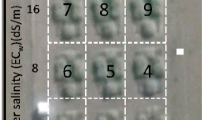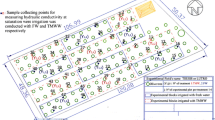Abstract
The quality of irrigation water has the potential to significantly affect soil structural properties, infiltration and irrigation application efficiency. While the effect of electrolyte concentration (as indicated by the electrical conductivity EC) and sodium adsorption ratio (SAR) have been studied under laboratory conditions, the effect on soil profile structural properties and irrigation performance have not been widely investigated under field conditions. In this paper, water with three different levels of sodium (SAR = 0.9, 10 and 30) was applied as alternative treatments to a clay loam soil. The application of 238–261 mm of medium- to high-SAR water was found to reduce aggregate stability, increase the bulk density of both the surface crust and underlying soil, and reduce the total depth of infiltration and final infiltration rate. Where low-SAR water was used, there was no significant (P<0.05) difference in final infiltration rate after the first four irrigations. However, where moderate- and high-SAR water was applied after the first four irrigations with the low EC-SAR water, the final infiltration rate was found to decrease on each of the successive irrigation events. For the moderate- and high-SAR treatments, this suggests that a steady-state equilibrium had not been reached within that part of the soil profile impeding infiltration. It is proposed that the initial reduction in infiltration is related to the physical processes of slaking leading to the development of an apedal, hardsetting surface soil layer. Similarly, it is proposed that the subsequent increase in bulk density and decline in infiltration where moderate and high EC-SAR water is applied is due to an increase in clay tactoid swelling reducing the size of the conducting micropores, dispersion blocking pores, and/or an increase in the thickness of the apedal surface layer. The reduction in infiltration associated with the use of high-SAR irrigation water was found to reduce the performance of the irrigations, with the application efficiency of the final irrigation decreasing from 40% where the low-SAR water was used, to 21% where the high-SAR water was applied. The implications for surface irrigating with water containing high sodium levels are discussed.

Similar content being viewed by others
References
Agassi M, Shainberg I, Morin I (1981) Effect of electrolyte concentration and soil sodicity on the infiltration rate and crust formation. Soil Sci Soc Am J 45:848–851
Allison LE, Moodie CD (1965) Carbonate. In: Klute A (ed) Methods of soil analysis. Part 2: chemical and microbiological properties. (Monograph no. 9) ASA, Madison, Wis.
Alperovitch N, Shainberg I, Keren R, Singer MJ (1985) Effect of clay mineralogy, Al and Fe oxides on hydraulic conductivity of clay-sand mixtures. Clays Clay Miner 33:443–450
Blake GR, Hartge KH (1986) Bulk density. In: Klute A (ed) Methods of soil analysis. Part 1: physical and mineralogical methods. (Monograph no. 9, 2nd edn) ASA, Madison, Wis., pp 363–375
Caron J, Kay BD, Stone JA (1992) Improvement of structural stability of a clay loam with drying. Soil Sci Soc Am J 56:1583–1590
Chamberlain AR (1952) Measuring water in small channels with WSC flume. (Stations circular 200) State College of Washington
Chapman HD (1965) Cation exchange capacity. In: Klute A (ed) Methods of soil analysis. Part 2: chemical and microbiological properties. (Monograph no. 9) ASA, Madison, Wis.
Elliott RL, Walker WR (1982) Field evaluation of furrow infiltration and advance functions. Trans ASAE 396–400
Elliott RL, Walker WR, Skogerboe GW (1983) Infiltration parameters from furrow irrigation advance data. Trans ASAE 1726–1731
Gee GW, Bauder JW (1986) Particle size analysis. In: Klute A (ed) Methods of soil analysis, Part 1: physical and mineralogical methods. (Monograph no. 9, 2nd edn) ASA, Madison, Wis.
Isbell RF (1995) Sealing, crusting and hardsetting conditions in Australian soils. In: So HB, Smith GD, Raine SR, Schafer BM, Loch RJ (eds) Sealing, crusting and hardsetting soils: productivity and conservation. Australian Society of Soil Science, Brisbane, pp 15–29
Kemper WD, Rosenau RC (1986) Aggregate stability and size distribution. In: Klute A (ed) Methods of soil analysis. Part 1: physical and mineralogical methods. (Monograph no. 9, 2nd edn) ASA, Madison, Wis.
Keren R, Shainberg I (1981) The efficiency of industrial and mined gypsum in reclamation of a sodic soil: rate of dissolution. Soil Sci Soc Am J 45:103–107
Levy GJ, Miller WP (1997) Aggregate stability of some southern US soils. Soil Sci Soc Am J 61:1176–1182
McNeal BL, Coleman NT (1966) Effect of solution composition on soil hydraulic conductivity. Soil Sci Soc Am Proc 30:308–312
McNeal BL, Norvell WA, Coleman NT (1966) Effect of solution composition on the swelling of extracted soil clays. Soil Sci Soc Am Proc 30: 313–317
Mullins CE, MacLeod DA, Northcote KH, Tisdale JM, Young IM (1990) Hardsetting soils: behaviour, occurrence and management. In: Lal R, Stewart BA (eds) Soil degradation. (Advances in soil science vol 11) Springer, Berlin Heidelberg New York, pp 37–108
Raine SR, McClymont DJ, Smith RJ (1998) The effect of variable infiltration on design and management guidelines for surface irrigation. In: Proceedings of the ASSSI national soils conference, 27–29 April, Brisbane. ASSSI, pp 311–317
Rasiah V, Kay BD, Martin T (1992) Variation of structural stability with water content: Influence of selected soil properties. Soil Sci Soc Am J 56:1604–1609
Rich CI (1965) Elemental analysis by flame photometry. In: Klute A (ed) Methods of soil analysis. Part 2: chemical and microbiological properties. (Monograph no. 9) ASA, Madison, Wis.
Shafique MS, Skogerboe GV (1983) Impact of seasonal infiltration function variation on furrow irrigation performance. In: Advances in infiltration: proceedings of national conference. ASAE, St Joseph, pp 292–301
Shainberg I, Letey J (1984) Response of soils to sodic and saline conditions. Hilgardia 52(2):1–57
Stout PR, Johnson CM (1965) Chlorine and bromine. In: Klute A (ed) Methods of soil analysis. Part 2: chemical and microbiological properties. (Monograph no. 9) ASA, Madison, Wis.
Walker WR (1996) SIRMODII: surface irrigation simulation, evaluation and design. Biological and Irrigation Engineering, Utah State University, Logan, Utah
Walker WR, Skogerboe GV (1987) Surface irrigation: theory and practice. Prentice-Hall, N.J.
Youker RE, McGuiness JL (1956) A short method of obtaining mean weight diameter values of aggregate analyses of soils. Soil Sci 83:291–294
Author information
Authors and Affiliations
Corresponding author
Additional information
Communicated by A. Kassam
Rights and permissions
About this article
Cite this article
Emdad, M.R., Raine, S.R., Smith, R.J. et al. Effect of water quality on soil structure and infiltration under furrow irrigation. Irrig Sci 23, 55–60 (2004). https://doi.org/10.1007/s00271-004-0093-y
Received:
Accepted:
Published:
Issue Date:
DOI: https://doi.org/10.1007/s00271-004-0093-y




